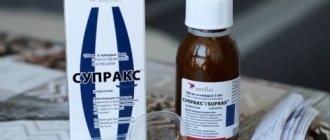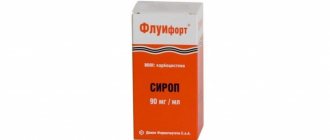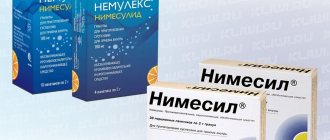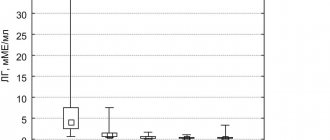Pharmacodynamics and pharmacokinetics
Pharmacodynamics
Semi-synthetic antibiotic of the penicillin series , has a bactericidal . The mechanism of action is associated with inhibition of the synthesis of the cell membrane of dividing microorganisms: it disrupts the peptide bonds in it, which leads to a decrease in the resistance of the bacterial cell and to lysis. Acid resistant. Shows activity against gram-positive ( staphylococcus , streptococcus ) and gram-negative microorganisms ( Klebsiella pneumoniae , Protea , Salmonella , Shigella , Escherichia coli , influenza bacteria).
It is of interest as a drug for the treatment of purulent surgical infections , urinary tract infections , cholangitis and cholecystitis . Effective for the treatment of bacterial respiratory tract infections (community-acquired pneumonia , bronchitis , otitis media , sinusitis ), meningitis , endocarditis (in combination with Gentamicin ), intestinal infections ( shigellosis )
It is destroyed by penicillinase and is therefore ineffective against penicillinase-forming staphylococci . Attempts have been made to “protect” the antibiotic from destruction by bacterial enzymes. “Protected” penicillins are combinations with enzyme inhibitors: Ampicillin + Sulbactam (drug Unazin , Sultasin and others). Sulbactam does not have an antibacterial effect, but inhibits beta-lactamases, so in this combination the antibiotic also acts on resistant strains of microorganisms.
Pharmacokinetics
Absorption is rapid, bioavailability is 40%. The maximum concentration in the blood is determined after 2 hours. It is 20% bound to proteins. In therapeutic concentrations it is found in pleural and synovial fluids, the contents of blisters, high concentrations in urine, gall bladder, lungs, genitals, bile, bronchial secretions, bones, paranasal sinuses, middle ear, saliva.
Excreted by the kidneys (70-80%), partly with bile, and with breast milk. High concentrations of the antibiotic are found in the urine. Does not accumulate with repeated use.
Pharmacological properties of the drug Ampicillin
Semi-synthetic antibiotic of the penicillin group. It has a bactericidal effect by competitively blocking transpeptidases involved in the synthesis of mucopeptide, which is part of the cell membrane. Active against proliferating bacteria. Effective against gram-positive and some gram-negative microorganisms, including E. coli, Proteus mirabilis, Salmonella spp., Shigella spp., Haemophilus influenzae, Bordetella pertussis, Neisseria gonorrhoeae, Neisseria meningitidis. Ampicillin is also active against gram-positive anaerobic cocci and bacteria (Peptococcus spp., Pertosteptococcus spp., Clostridium spp., Corynebacterium spp.). Penicillinase-forming staphylococci are resistant to ampicillin. When taken orally, ampicillin is not destroyed in the acidic environment of the stomach and is well absorbed in the digestive tract. Concomitant food intake reduces the absorption of the antibiotic. The maximum concentration in the blood is reached 1–2 hours after administration and decreases slowly over 6 hours. The maximum concentration in the blood plasma after intramuscular administration is reached after 1 hour. About 28% of ampicillin is bound to plasma proteins. The half-life from blood plasma is 1–2 hours; in newborns, elderly patients and patients with impaired renal function, it may be prolonged. Ampicillin is well distributed in tissues and body fluids. It weakly penetrates the blood-brain barrier; during meningitis, its concentration in the cerebrospinal fluid increases. Penetrates through the placental barrier. Found in small quantities in breast milk. It is excreted unchanged by the kidneys through glomerular filtration and tubular secretion; about 20% of the antibiotic is excreted in the bile. Partially removed during hemodialysis.
Indications for use
- sinusitis , tonsillitis , otitis , pharyngitis , bronchitis , abscess , pneumonia ;
- urinary tract infection;
- pyelonephritis;
- cholangitis;
- gonorrhea , cervicitis ;
- chlamydia in pregnant women;
- erysipelas , impetigo , infected dermatoses ;
- scarlet fever;
- pasteurellosis , listeriosis ;
- salmonellosis and its carriage, typhoid fever , dysentery ;
- peritonitis;
- endocarditis;
- meningitis;
- septicemia.
Side effects
- itching, peeling of the skin;
- rhinitis , urticaria , Quincke's edema ;
- rarely - maculopapular rash, fever, dermatitis , erythema and anaphylactic shock ;
- dysbiosis , gastritis , change in taste, dry mouth, abdominal pain, nausea, diarrhea, vomiting;
- stomatitis , glossitis , pseudomembranous enterocolitis ;
- agitation, aggressiveness, anxiety, depression, convulsions;
- leukopenia , thrombocytopenia , agranulocytosis ;
- nephritis , nephropathy ;
- vaginal candidiasis.
Side effects of the drug Ampicillin
Allergic reactions, nausea, vomiting, diarrhea, candidiasis of the oral mucosa, pseudomembranous colitis (both during treatment and several weeks after its cessation) are possible; reversible disorders of hematopoiesis and, in some cases, interstitial nephritis are rarely observed. During treatment with ampicillin, transient increases in serum aminotransferases, LDH, ALP and creatinine, a false-positive glucosuric test and a false-positive Coombs test may occur.
Instructions for use of Ampicillin (Method and dosage)
Ampicillin tablets, instructions for use
The drug in tablets or capsules is taken orally. Dosage for adults: 250-500 mg (depending on the severity of the disease) 1 hour before meals 4 times a day.
For urinary tract infections, 500 mg 4 times a day. For gonococcal urethritis, a single dose of 3.5 g is prescribed. Adults can take ampicillin tablets in a maximum daily dose of 4 g. For children, it is preferable to prescribe it in the form of a suspension, as will be discussed below.
Ampicillin/sulbactam tablets contain two parts standard dosage ampicillin and one part sulbactam. The method of their use and dosage is the same.
Ampicillin injections, instructions for use
After preparing the solution, it is administered intramuscularly or intravenously. When performing intramuscular injections, add 2 ml of Novocaine , water for injection or Lidocaine . For intravenous administration, a single dose is dissolved in 10 ml of isotonic solution or glucose solution. For a single dose of more than 2 g, it is administered dropwise; for this, 250 ml of an isotonic solution is added to the resulting antibiotic solution and 60 drops per minute are administered.
For moderate infections, adults and children weighing more than 20 kg - intramuscularly 250 - 500 mg 4 times a day, in more severe cases - 1 - 2 g 4 times a day. For meningitis - 14 g/day, divided into 6 - 8 injections. For children weighing up to 20 kg, the dose is 12.5 - 25 mg/kg per day, over 20 kg - 50-100 mg/kg per day. For meningitis, newborns weighing up to 2 kg are prescribed intravenously 25 mg per kg body weight every 12 hours throughout the first week, then 50 mg per kg body weight every 8 hours.
Special instructions for the use of Ampicillin
Before using ampicillin, a sensitivity test to the antibiotic should be performed. Use extreme caution in patients with hypersensitivity to cephalosporins, griseofulvin or penicillamine. During long-term treatment with ampicillin, it is recommended to periodically monitor the function of the kidneys, liver and hematopoietic organs. The possibility of superinfection caused by pathogenic fungi or resistant bacteria should be considered. If superinfection develops, adequate therapy is prescribed.
Interaction
Bacteriostatic agents ( macrolides , chloramphenicol , sulfonamides , lincosamides , tetracyclines ) have an antagonistic effect, bactericidal antibiotics ( aminoglycosides , Vancomycin , cephalosporins , Rifampicin ) have a synergistic effect.
Antacids and laxatives , food intake reduce absorption, and ascorbic acid .
Strengthens the effect of anticoagulants , reduces the effectiveness of estrogen- containing contraceptives .
Diuretics , Allopurinol , Phenylbutazone , Oxyphenbutazone , NSAIDs , increase the concentration of the active substance due to a decrease in tubular secretion.
Concomitant use of Allopurinol causes a risk of skin rash.
Enhances the absorption of Digoxin . Increases the toxicity of Methotrexate .
Drug interactions Ampicillin
If combined parenteral treatment with ampicillin and aminoglycoside antibiotics is necessary, they should be administered at different sites with an interval of 1 hour due to the risk of inactivation. Ampicillin may cause a decrease in the effectiveness of oral hormonal contraceptives. Ampicillin in high doses reduces the level of atenolol in the blood plasma, so it is recommended to use these drugs separately, and take atenolol before using ampicillin. Concomitant use with allopurinol significantly increases the likelihood of skin rash. Probenecid may reduce the renal excretion of ampicillin and lead to increased plasma concentrations. During treatment with ampicillin, false-positive results of non-enzymatic glucosuric tests can be determined.
Ampicillin for children
The suspension for children is intended for use from one month of age. To prepare it, add boiled water to the bottle with granules to the mark, shake, and store at room temperature for 2 weeks. Shake thoroughly before use. Pay attention to the dosage - there are suspensions containing 125 mg and 250 mg of active substance. If we take the last option, then in 1 full measuring spoon (5 ml of suspension) there will be 250 mg of the active substance, the bottom mark of the spoon corresponds to 125 mg.
Dosage for children with mild infection: up to 1 year - at the rate of 100 mg/kg body weight per day, from 1 year to 4 years - 100-150 mg/kg body weight per day, over 4 years - 1-2 g per day. The required dose should be given in 4 or 6 doses.
Ampicillin and alcohol
The instructions do not mention anything about whether alcohol and ampicillin are combined. However, upon reflection, we can conclude that drinking alcohol can cause or intensify adverse reactions, reduce the content of the active substance in tissues and reduce the effectiveness of antibiotic therapy. And this is due to the fact that when drinking alcohol, the cytochrome P450 (it is induced), and the enzymes of other cytochromes necessary for drug metabolism are suppressed. of glucuronic acid , which is necessary for binding toxic substances and drug metabolites, is also reduced
Ampicillin analogues
Level 4 ATC code matches:
Hiconcil
Ampioks
Ampicillin Trihydrate
Ospamox
Amoxicar
Penicillin
Flemoxin Solutab
Amoxicillin
Amosin
Amoxil
Ecoball
Analogs with one active ingredient: Pentrexil , Penodil , Zetsil , Standacillin .
Reviews about Ampicillin
What is Ampicillin tablets for? This is an antibiotic of the penicillin , so it is used for various infections, including, has not lost its relevance in the treatment of shigellosis . Ampicillin is still widely used today, primarily due to the fact that it is available to the vast majority of patients and practically does not cause liver dysfunction (frequency less than 0.1%, compared to Cefotaxime 8% and aminoglycodides - 15%). In medical practice, Ampicillin capsules and tablets are used in the form trihydrate , as well as granules for preparing a suspension. It must be said that oral forms of this drug have low bioavailability - only 40%. As a drug for intramuscular administration, it is effective in the treatment of many infections, but as a drug for oral administration in most cases it is inferior to Amoxicillin , the advantage of which is better and stable absorption, the absence of influence on it by food intake, and also a smaller frequency of use. In addition, oral administration of this drug can cause dysbiosis , while Amoxicillin slightly suppresses the flora. Frequent use of the drug in children (every 4 months) can lead to fluorosis - a defect in tooth enamel.
Reviews of Ampicillin are mostly related to its use for sore and sinusitis , for severe cases of which injections of “pure” ampicillin or its combination with sulbactam - Ampisulbin , Sultasin or Ouanazine .
Indications for use include its use for infections of the ear, throat, paranasal sinuses, cystitis and pyelonephritis . The choice of this drug for pyelonephritis is explained by the lack of nephrotoxicity, the effect on E. coli (the main cause of urinary tract infections) and the ability to be excreted in urine in therapeutic concentrations.
For uncomplicated pyelonephritis, treatment began with ampicillin. fluoroquinolones or cephalosporins were added after 2–3 days . Only some patients experienced nausea, vomiting, stool upset, rash and itching during treatment.
Ampicillin 250 mg/5 ml 100 ml granules for suspension for oral administration
Composition and release form Ampicillin 250 mg/5 ml 100 ml granules for the preparation of suspension for oral administration
Powder for preparing a solution for intravenous and/or intramuscular administration - 1 fl. ampicillin sodium salt - 1 g - 2 g in 10 ml bottles; 1 bottle in a cardboard pack. Lyophilisate for preparing a solution for intravenous and intramuscular administration - 1 fl. ampicillin sodium salt - 250 mg - 500 mg in vials. Powder for the preparation of an injection solution for intramuscular administration - 1 fl. ampicillin sodium salt - 1 g - 2 g in bottles; 1 bottle in a cardboard pack. Powder for the preparation of an injection solution for intramuscular administration - 1 fl. ampicillin sodium salt - 250 mg - 500 mg in vials. Powder for the preparation of suspension for oral administration 250 mg/5 ml - 1 fl. ampicillin - 5 g excipients: PVP; sodium glutamate; sodium phosphate disubstituted or disodium phosphate anhydrous; trilon B; glucose; vanillin; aromatic food essence (raspberry); refined sugar or refined powdered sugar in polyethylene bottles of 150 or 250 ml, complete with a measuring cup; in a cardboard pack 1 bottle Tablets - 1 tablet. ampicillin trihydrate - 250 mg excipients: potato starch; magnesium stearate; talc; PVP; Tween-80 in blister pack 10 pcs.; in a cardboard pack or without it and in a contour-free packaging 10 pcs. Substance-powder - 1 can of ampicillin sodium salt, sterile 2; 5 or 10 kg in aluminum cans; in a drum (2 kg) or plastic bags, 1 can.
Description of the dosage form
Powder for the preparation of a suspension for oral administration is white with a yellowish tint, with a specific odor. The finished suspension is a white suspension with a yellowish tint. Tablets are white, flat-cylindrical in shape with a chamfer and a score. The powder for preparing the injection solution is white and hygroscopic.
Directions for use and doses
Powder for preparing a solution for intramuscular administration
They are set individually depending on the severity of the disease, the location of the infection and the sensitivity of the pathogen.
When taken orally for adults, a single dose is 250-500 mg, frequency of administration is 4. Children weighing up to 20 kg - 12.5-25 mg/kg every 6 hours. For IM, IV administration, a single dose for adults is 250-500 mg every 4-6 hours. For children, a single dose is 25-50 mg/kg. The duration of treatment depends on the location of the infection and the characteristics of the course of the disease. Maximum daily dose: for adults when taken orally - 4 g, with IV and IM administration - 14 g. Granules for preparing a suspension for oral administration
Orally, 0.5–1 hour before meals. The dosage is determined individually, taking into account the severity of the infection. Adults and children over 10 years old - 250-500 mg every 6 hours. The daily dose is 2-3 g (if necessary, it can be doubled). For gonococcal urethritis - 3.5 g once. For children, the daily dose is 100 mg/kg in 4-6 doses. In case of mild infection, it is preferable to prescribe the drug in the form of a suspension. The duration of the course is 5–14 days (depending on the location of the infection and the characteristics of the course of the disease).
Pharmacodynamics
Active against gram-positive microorganisms, incl. Staphylococcus spp. (except for penicillinase-producing strains), Streptococcus spp. (including Enterococcus spp.), gram-negative microorganisms, incl. Neisseria gonorrhoeae, Neisseria meningitidis, Escherichia coli, Shigella spp., Salmonella spp., Bordetella pertussis, some strains of Haemophilus influenzae, Klebsiella pneumoniae, aerobic non-spore-forming bacteria - Listeria monocytogenes. Destroyed by penicillinase, acid-resistant.
Pharmacokinetics
When taken orally, it is well absorbed from the gastrointestinal tract and is not destroyed in the acidic environment of the stomach. When administered parenterally (i.m., i.v.), the concentration in the blood exceeds that created when administered orally. T1/2 - 2 hours. Distributed in most organs and tissues, found in therapeutic concentrations in pleural, peritoneal and synovial fluids. It penetrates the BBB poorly; with inflammation of the meninges, the permeability of the BBB increases sharply. 30% of ampicillin is metabolized in the liver. It is excreted mainly in urine (70-80%) and bile; high concentrations of unchanged drug are created in the urine. Ampicillin trihydrate and ampicillin sodium salt do not accumulate with repeated administrations.
Indications for use Ampicillin 250 mg/5 ml 100 ml granules for the preparation of suspension for oral administration
Powder for preparing a solution for intramuscular administration
Infectious and inflammatory diseases caused by microorganisms sensitive to ampicillin: incl.
infections of the ear, throat, nose, odontogenic infections, bronchopulmonary infections, acute and chronic urinary tract infections, gastrointestinal infections (including salmonellosis, cholecystitis), gynecological infections, meningitis, endocarditis, septicemia, sepsis, rheumatism, erysipelas, scarlet fever, skin and soft tissue infections. Granules for the preparation of a suspension for oral administration
Infections of the respiratory and urinary tract, gastrointestinal tract, meningitis, endocarditis, sepsis, whooping cough.
Contraindications
Powder for preparing a solution for intramuscular administration
Infectious mononucleosis, lymphocytic leukemia, hypersensitivity to ampicillin and other penicillins, liver dysfunction.
Granules for the preparation of a suspension for oral administration
Hypersensitivity, liver dysfunction, pregnancy, children (up to 1 month).
Application of Ampicillin 250 mg/5 ml 100 ml granules for the preparation of suspension for oral administration during pregnancy and lactation
Powder for preparing a solution for intramuscular administration
It is possible to use ampicillin during pregnancy according to indications.
Ampicillin is excreted in breast milk in low concentrations. If it is necessary to use ampicillin during lactation, the issue of stopping breastfeeding should be decided. Use in children is possible according to the dosage regimen. Granules for the preparation of a suspension for oral administration.
Contraindicated during pregnancy and in childhood under 1 month.
special instructions
Use with caution for bronchial asthma, hay fever and other allergic diseases, and desensitizing agents are prescribed at the same time. If allergic reactions occur, the drug is discontinued and desensitizing therapy is prescribed. If signs of anaphylactic shock appear, urgent measures must be taken to remove the patient from this state. In weakened patients, during long-term treatment, superinfection caused by drug-resistant microorganisms (candidiasis) may develop; When treating such patients with the drug, it is advisable to prescribe B vitamins and vitamin C, and, if necessary, nystatin or levorin. During treatment, systematic monitoring of renal function, liver function (especially in case of liver failure), and peripheral blood patterns is necessary. In patients with impaired renal function, adjustment of the dosage regimen is required in accordance with creatinine clearance values. The use of high doses in patients with renal failure can lead to toxic effects on the central nervous system. When ampicillin is used in patients with bacteremia (sepsis), a bacteriolysis reaction (Jarisch-Herxheimer reaction) is possible.
Side effects Ampicillin 250mg/5ml 100ml granules for suspension for oral administration
Powder for preparing a solution for intramuscular administration
Allergic reactions: urticaria, erythema, Quincke's edema, rhinitis, conjunctivitis;
rarely - fever, joint pain, eosinophilia; extremely rarely - anaphylactic shock. From the digestive system: nausea, vomiting. Effects caused by chemotherapy: oral candidiasis, vaginal candidiasis, intestinal dysbiosis, colitis caused by Clostridium difficile. Granules for the preparation of a suspension for oral administration
. Dyspeptic symptoms, central nervous system disorders, dysbacteriosis, candidiasis, allergic reactions.
Drug interactions
Probenecid reduces the tubular secretion of ampicillin, as a result of which the concentration of the latter in the blood increases and the risk of developing toxic effects increases. When taken together with allopurinol, the likelihood of skin rash increases. When used simultaneously with oral estrogen-containing drugs, a decrease in their effectiveness is observed (due to weakening of the hepatic circulation of estrogen). Ampicillin enhances the effect of oral anticoagulants and aminoglycoside antibiotics.
Ampicillin price, where to buy
You can buy this drug in many pharmacies in Moscow.
The price of Ampicillin tablets 250 mg No. 20 ranges from 16 rubles. up to 21 rub. One bottle of Ampicillin sodium salt powder 500 mg costs 7-9 rubles.
To purchase the drug, you will need a prescription in Latin, issued by a doctor.
- Online pharmacies in RussiaRussia
- Online pharmacies in UkraineUkraine
- Online pharmacies in KazakhstanKazakhstan
LuxPharma* special offer
- Ampicillin amp.
1 g No. 10 1900 rub. order
show more
Pharmacy24
- Ampicillin-KMP 250 mg No. 10 tablets PAT "Kievmedpreparat", Ukraine
20 UAH. order - Ampicillin-KMP 250 mg No. 20 tablets PAT "Kievmedpreparat", Ukraine
36 UAH order
- Ampicillin-KMP 0.5 g PAT "Kievmedpreparat", Ukraine
7 UAH order
- Ampicillin-KMP 1 g PAT "Kievmedpreparat", Ukraine
9 UAH order
PaniPharmacy
- Ampicillin tablets Ampicillin t/g tablet. 0.25g No. 20 Ukraine, Kievmedpreparat OJSC
42 UAH order
- Ampicillin bottle Ampicillin sodium salt powder for injection 1g Ukraine, Kievmedpreparat OJSC
11 UAH order
- Ampicillin tablets Ampicillin t/g tablet. 0.25g No. 10 Ukraine, Kievmedpreparat OJSC
21 UAH order
show more




